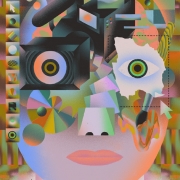
We take a look back at over 20 years in the digital world and the players involved. Then most importantly, it’s time to focus our eyes on the road ahead, as digital agencies, and the challenges we will have to face. Action!
The new Western
It’s a tired metaphor. Way back in 1990, when American activists were worrying that the government was going to take over the Internet, they named their cause the Electronic Frontier Foundation [1]. And the word “Frontier” wasn’t chosen at random. In the American West, the frontier was the artificial boundary between a civilised world governed by laws and a wild and untamed territory [2].
The EFF saw the burgeoning web as the new Wild West, a country beyond the American frontier, where people could say whatever they liked, and were free to create, undertake and experiment.
The metaphor still holds some truth, but history has now caught up with digital. For those who have been living in the digital world for the last twenty years, life is now strangely reminiscent of Once Upon a Time in the West [3].
Twenty years ago, pioneers created the first websites, the first businesses, taking advantage of the opportunities offered by a free and boundless world. Ten years ago, the first infrastructures – search engines, social networks, eCommerce platforms – began to consolidate, and become successful companies. The internet is now comparable to big cities that sprouted from the desert: some companies are still flourishing, but only under the cover of GAFA, and the infrastructure they provide at varying costs. The pioneers have become the users. From creators who started out with the tools to express themselves in a basic style, pioneers have now become residents in a gigantic network of sites and platforms with which they interact daily.
The Electronic Frontier of the pioneers has all but disappeared, giving way to a digital space that we would like to think of as civilised, or at least created logically and with infrastructure. And their fear of the internet falling under the jurisdiction of the government has now given way to their concerns about the stranglehold of Silicon Valley giants.
Our internet civilisation begs the question: where are humans in all this?
The Civilisation of the internet
While its infrastructure has become more sophisticated, the internet has also become democratised. Such a large number of human beings have never been connected to the same tool at the same time. All you need to do is take a look at the attendance figures of some social networks to realise how much digital technology has disappeared from our screens… and given way to interactions: Facebook reports 2.2 billion users, Instagram 1 billion amateur photographers and WeChat has exceeded 1 billion members.
But what do these figures really mean? Do digital users have a real understanding of the ecosystems to which they are contributing? Far removed from the approach taken by the pioneers and creators of the digital world, today’s users consume digital interfaces superficially, without knowing how they work, nor even being aware of the consequences of how they generate and share their content.
In a digital and increasingly automated world that relies more and more on algorithms – and soon Artificial Intelligence – digital illiteracy is becoming more serious, and more widespread.
The myth of the Digital Native – a child who grew up with a computer being naturally gifted for technology – has long since been disproven…
Honesty and transparency
So without full knowledge of how it all works, users not only need simple interactions, but also clear and straightforward interfaces that are honest about the impact of their online behavior, or which digital players are privvy to the content they share. Better still, interfaces are needed that educate and enlighten people about the real issues of our digital society. Between Cambridge Analytica and GDPR, 2018 has been a year of raising awareness.
Digital interactions must be created transparently and honestly, but must also be simple and beautiful to look at. In a nutshell, they need a great design.
These concerns are at the heart of the design profession. Designers should be coming up with systems that interact with humans while being practical, aesthetic, real and economically viable.
Theory of evolution
Between giant and industrial infrastructures and users who aren’t fully aware of what they are doing or what they could be doing, intermediaries need to start redefining their roles.
More specifically, digital agencies that support companies in their daily digital experiences, those that provide users with the tools, content and interfaces that are the gateway to the digital world need to take a good hard look at what they are developing.
Web agencies used to create ecosystems (websites, platforms, intra- and extranets), but are now seeing their role slowly mature.
First because the systems used to create digital platforms are being industrialised. CMS, Workframe and other SAAS platforms sometimes render custom development completely unnecessary. Brands are now online, and services often involve adjusting an existing solution rather than developing an idea from scratch.
Audiences are also now gathering on a handful of very large platforms. Facebook, Instagram, YouTube, as well as other content platforms attract billions of users every day, and have become cornerstones to the online experience. And it’s often easier and more useful to approach people on these networks rather than trying to create a new online contact point. Digital consumers are now being targeted on the spaces and systems they already use.
Digital agencies are having to answer a new question: they are no longer asked to create new ways to use a system, but how to make the most of the existing digital space. They are asked to optimise digital interactions between brands and users. Morphing from their role as creators and builders, agencies have now become developers, interior designers, promoters…
In a word, they are now being asked to design.
Digital agency, Design agency
What is Design? According to some definitions, including Wikipedia’s suggestion, design is the intentional creation of a plan or specification for the construction of an object or system or for the implementation of an activity of process. Design is where art, technology and society converge. And that’s what digital agencies are doing right now.
Agencies aren’t just creating websites, campaigns or content, they are also coming up with the tools and methods that allow these elements to exist and be maintained in the long term. What about the aesthetic and technical aspects of the internet? They’ve been an integral part of agency work for years. Any online content needs to be effective and beautiful, useful and enjoyable. That’s what the internet is all about.
Perhaps the new element in all this is societal responsibility. Digital agencies are now creating, designing, and recommending digital tools to a vast audience whose daily life can be influenced and transformed at the tap of a finger. And that responsibility – if not societal, then at least human – must now be shouldered by all online companies.
Creating daily digital interactions is what makes digital agencies genuine designers in their own right.
—
Translated from French by Ruth Simpson
This page is available in FR





